Phototroph - Study guides, Class notes & Summaries
Looking for the best study guides, study notes and summaries about Phototroph? On this page you'll find 98 study documents about Phototroph.
All 98 results
Sort by
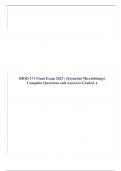 Popular
Popular
-
BIOD 171 Final Exam 2023 | (Essential Microbiology) Complete Questions and Answers Graded A+
- Exam (elaborations) • 23 pages • 2024
-
- $20.00
- 1x sold
- + learn more
BIOD 171 Final Exam 2023 | (Essential Microbiology) Complete Questions and Answers Graded A+. Describe the primary distinction between prokaryotic and eukaryotic cells. Prokaryotic Cell do not contain a nucleus in which all organelles are present inside of them that carry genetic substances like DNA unlike the Eukaryotic cells that contain a nucleus Answer: Eukaryotic cells have a defined, membrane-bound nucleus that contains the genetic material. Prokaryotic cells do not contain a nucleus, and ...
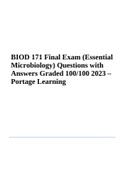
-
BIOD 171 Final Exam 2023 | (Essential Microbiology) Complete Questions and Answers Graded A+
- Exam (elaborations) • 20 pages • 2023
- Available in package deal
-
- $20.49
- 11x sold
- + learn more
BIOD 171 Final Exam 2023 | (Essential Microbiology) Complete Questions and Answers Graded A+. Describe the primary distinction between prokaryotic and eukaryotic cells. Prokaryotic Cell do not contain a nucleus in which all organelles are present inside of them that carry genetic substances like DNA unlike the Eukaryotic cells that contain a nucleus Answer: Eukaryotic cells have a defined, membrane-bound nucleus that contains the genetic material. Prokaryotic cells do not contain a nucleu...
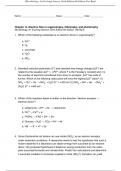
-
Chapter 14. Electron flow in organotrophy, lithotrophy, and phototrophy Microbiology: An Evolving Science 6th Edition, Joan L. Slonczewski Test Bank with Answers Key
- Exam (elaborations) • 28 pages • 2023
-
Available in package deal
-
- $26.49
- + learn more
Chapter 14. Electron flow in organotrophy, lithotrophy, and phototrophy Microbiology: An Evolving Science 6th Edition, Joan L. Slonczewski Test Bank with Answers Key
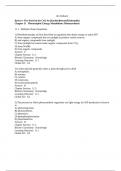
-
Becker's The World of the Cell, 9e(Hardin/Bertoni/Kleinsmith)Chapter 11Phototrophic Energy Metabolism: Photosynthesis
- Other • 135 pages • 2023
-
- $25.49
- + learn more
11.1 Multiple-Choice Questions 1) Photoheterotrophs are best described as organisms that obtain energy to make ATP A) from organic compounds but use sunlight to produce carbon sources. B) and organic compounds from sunlight. C) from sunlight but cannot make organic compounds from CO2. D) from NADH. E) from organic compounds. Answer: C Chapter Section: 11.1 Bloom's Taxonomy: Knowledge Learning Outcome: 11.1 Global LO: G2 2) Carbon dioxide generally enters a plant through pores called...
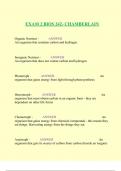
-
EXAM 2 BIOS 242- CHAMBERLAIN
- Exam (elaborations) • 21 pages • 2024
- Available in package deal
-
- $11.49
- + learn more
EXAM 2 BIOS 242- CHAMBERLAIN Organic Nutrient - ANSWER An organism that contains carbon and hydrogen Inorganic Nutrient - ANSWER An organism that does not contan carbon and hydrogen Phototroph - ANSWER An organism that gains energy from light through photosynthesis Heterotrop...

-
Ultimate AP Biology Exam Review Questions with Verified Answers
- Exam (elaborations) • 23 pages • 2024
- Available in package deal
-
- $9.99
- + learn more
Ultimate AP Biology Exam Review Questions with Verified Answers Compare and contrast transpiration and translocation. What is the difference between xylem and phloem? Tranpspiration is the loss of water vapor from the surgace of a plant through the stomata. Translocation is the channeling of the sugar through the phloem. Define hypoosmotic, hyperosmotic, and isomotic 1. Has a lower concentration of solutes than its surrounding enviorment 2. Has a higher concentration of solutes than i...
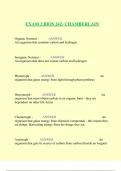
-
EXAM 2 BIOS 242- CHAMBERLAIN
- Exam (elaborations) • 21 pages • 2024
-
- $12.49
- + learn more
EXAM 2 BIOS 242- CHAMBERLAIN Organic Nutrient - ANSWER An organism that contains carbon and hydrogen Inorganic Nutrient - ANSWER An organism that does not contan carbon and hydrogen Phototroph - ANSWER An organism that gains energy from light through photosynthesis Heterotrop...
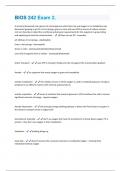
-
BIOS 242 Exam 2 Questions And Answers Graded A+
- Exam (elaborations) • 13 pages • 2024
- Available in package deal
-
- $7.99
- + learn more
A recently discovered new species of microorganism which does not use oxygen in its metabolism was discovered growing in pH 10, in hot springs, green in color and uses CO2 as source of carbon nutrient rich soil. Describe in detail the nutritional and physical requirements for this organism to grow, listing and explaining at least five characteristics. - Does not use O2 - anaerobe pH 10/lives in hot springs - alkalinophile Lives in hot springs - thermophile Green in color - photoautotroph/p...
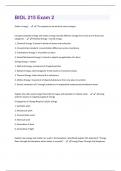
-
BIOL 215 Exam 2(Graded A+ actual test)
- Exam (elaborations) • 35 pages • 2024
- Available in package deal
-
- $7.99
- + learn more
Define 'energy'. - -The capacity to do work (to cause change) Compare potential energy and kinetic energy. Classify different energy forms into one of these two categories. - Potential Energy = stored energy 1. Chemical Energy: E stored in bonds of atoms and molecules 2. Concentration Gradient: concentration differences across membrane 3. Gravitational Energy: E of position or place 4. Stored Mechanical Energy: E stored in objects by application of a force Energy Energy = motion 1. Ele...

-
BIOS 242 Exam 2 Review Questions And 100% Correct Answers.
- Exam (elaborations) • 15 pages • 2024
-
Available in package deal
-
- $9.99
- + learn more
organic - Answer heterotrophs are? heterotroph - Answer •An organism that must obtain its carbon in organic form •Dependent on eating other life forms inorganic - Answer autotrophs are? autotroph - Answer •"Self-feeder" (photosynthesis or chemosynthesis) •Uses inorganic CO2 as its carbon source; builds organiccompounds from the CO2 phototroph - Answer an organism that gets its energy from sunlight chemotrophs - Answer Organisms that get energy from ch...

$6.50 for your textbook summary multiplied by 100 fellow students... Do the math: that's a lot of money! Don't be a thief of your own wallet and start uploading yours now. Discover all about earning on Stuvia


